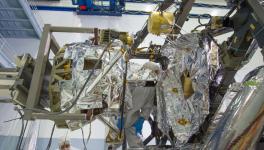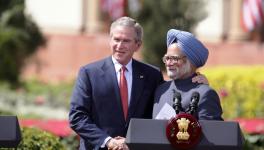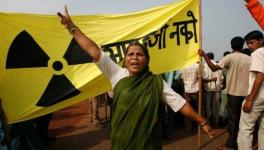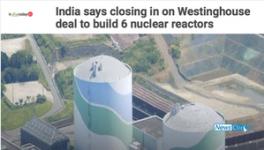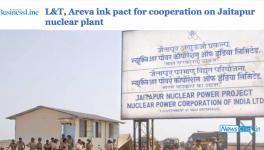Fukushima Plant Nearing Meltdown: Questions on India's Nuclear Program
The Fukushima Daiichi plant is perilously close to going out of control, if not already out of control. Hydrogen explosions have hit all the three reactors(units 1,2 and 3) that were working before the double whammy of earthquake and tsunami. While the containment buildings of two reactors – units 1 and 3 -- have blown up due to these explosions, their containment structures are still intact. However, the third explosion early Tuesday has caused a breach in the containment structure in the 3rd reactor, causing a huge spike in radiation levels in the plant. A hydrogen explosion means that fuel rods have been partially or fully uncovered and the metal cladding of the fuel pellets in the rods have been damaged due to heat – a state of partial melt-down – causing hydrogen to be released with fuel-water reactions.
Even more worrying is the fire in Unit No. 4, which was already shut-down before the earthquake. Here, the spent fuel rods have overheated and causing a fire and radio active materials to spew out. What this has created is a nightmare scenario of workers no longer able to work, as the radio activity levels are way above normal. It is estimated that at current levels, 7 minutes of exposure would mean that a worker will receive his maximum for the year. Tepco, the plant owner, has pulled most of the workers out of the plant and is trying to control the reactors from melting down with a skeletal force of only 50 workers. The key question now is that is it possible to indefinitely control the fuel meltdown, particularly in Reactor No 2, which has seen a containment breach and is finding it difficult to keep the fuels under the cover of cooling water?
Once the fuel becomes uncovered for long periods, the fuel rods start to melt. A full meltdown would see a mass of molten fuel material collect at the bottom of the containment vessel. If they eat through the containment vessel, we are in a near Chernobyl like situation, all protestations emanating from the nuclear industry to the contrary. Already, experts are conceding that this is the worst disaster after Chernobyl and ranks higher than Three Mile Island. On a nuclear accident scale of 1 to 7, Fukushima is now said to rank at a severity level of 5 or 6, just below Chernobyl which had a severity level of 7. Three Mile Island was rated at a severity level of 5.
The evacuation perimeter in Fukushima has now been increased to 30 Km, way beyond the Three Mile Island voluntary evacuation perimeter of 5 miles (or 8 Km), confirming that this is way above Three Mile Island in terms of severity. Worse, there are three reactors getting out of control in Fukushima, with a huge inventory of spent fuel lying in fuel ponds that are also equally vulnerable to overheating and fire.
Chief Cabinet Secretary Yukio Edano admitted on Tuesday that it is highly likely the containment vessel at the No.2 reactor building had been damaged and that the No.1, No.2 and No.3 reactors are all releasing hazardous radioactive material.
As an engineer, I must salute the Japanese workers, technician and engineers. They are working in conditions that are radio-active, facing unknown dangers and trying solutions that have never been tried before. That the plants have not already faced full-meltdown is a tribute to their skills and dedication. Unfortunately, this may not be enough to contain the scenario of a full fuel meltdown in multiple reactors.
The Indian Government has promised a full safety audit of the existing reactors. The Atomic Energy Commission has also said that they would review the Areva designs taking into consideration the experience of Fukushima. However, the prevailing voice within the nuclear energy establishment is one of smug complacency.
Nevertheless, I find it very hard to share such optimism. This is because the issue here is not that a safety audit should be done but who does this safety audit? We have an Atomic Energy Regulatory Board (AERB) that draws its personnel from Atomic Energy Commission, report to the Atomic Energy Commission and is even located in the Anushakti Bhavan, the headquarters of the Atomic Energy Commission. This is no way to run a critical safety regulatory function. It is also contrary to international practice as well as treaties that India has signed on the need to separate regulatory and operational functions in nuclear energy. This remains the single biggest obstacle for a safe nuclear energy program in the country.
It is not the best kept secret in the world that Indian plants have had problems at different points. The collapse of the Kaiga dome and the fire in Narora which caused all controls to be lost are cases in point. In Narora, again workers facing very heavy odds, managed a safe shut-down of the reactor manually. The point is with complete opacity surrounding the nuclear plants and the functioning of the Atomic Energy Commission and its attached body, the AERB, it is difficult to accept the results of the safety audit. We can already predict the report – all we need to do is to listen what the nuclear establishment has been saying for the last few days and we will know what the report is likely to say.
Interestingly, one of the points that the country's nuclear establishment has made repeatedly is that Pressurised Heavy Water Reactors (PHWRs) -- that are the bulk of the Indian reactors -- are much more safe than the Light Water Reactors (LWR's ). If this is indeed so, why the fascination for the LWRs which according to the nuclear establishment is less safe? Why then leave the tried and tested route of PHWRs for which we have indigenous capacity for imported reactors which by their own admission is less safe?
It is in this context we have to look at the controversial Jaitapur project. The Government is keen to put 6 units of 1650 MW EPR reactors of Areva, France make. Though Atomic Energy Commission chairman, Srikumar Bannerjee claims that this design is tested, as it has worthy predecessors, fact remains that there is not one plant of this design that has yet been commissioned. That a Fukushima type of accident of earthquake-cum-tsunami will not affect Jaitapur is no consolation as no two serious nuclear accidents have ever been alike. Question of how safe this plant is cannot be answered by saying a Fukushima type accident will not occur here.
Jaitapur plant proposes to have 5% enriched uranium as fuel against the normal enrichment of 3.5% for LWRs and natural uranium for PHWR's. It also has a higher burn rate than the current LWRs. Dr. Gopalkrishnan, former Chairman, AERB has asked in his article, (http://www.dnaindia.com/mumbai/column_jaitapur-deficit-of-public-trust_…)
“How much understanding, based on relevant data, do Areva and NPCIL together have on the radiological and physical behavior of high-burnup spent-fuel from these EPRs and the consequent serious safety issues related to its long-term storage, cooling, transport and reprocessing?” These questions are not going to be answered based on the belief of a few scientists.
It is interesting also to note that Areva, while claiming its technology is completely safe, has also been very unhappy with the prospect of liability that the current Indian law prescribes, even though the upper limit for such liability is only Rs. 1,500 crore. This itself shows how much confidence they have for their technology.
There is little doubt that Fukushima will cast a radioactive cloud over the nuclear renaissance promised by the nuclear industry. Nuclear technology still remains one of the most complex technologies that we know. Rushing in with ever larger sizes and complex designs have been the bane of this technology from the beginning. In their hurry to invite foreign suppliers for the Indian market, the Manmohan Singh Government never took this into account. All the reactors being pushed by foreign suppliers – Areva, GE and Westinghouse -- have the same problems regarding provenness of technology and complexity of design. If Fukushima gives a pause in this rush for costly and and untested imported reactors, at least we can say that this Government has an open mind. Otherwise, we will have to conclude that there is a different agenda at play, divorced from the need for nuclear energy.
Get the latest reports & analysis with people's perspective on Protests, movements & deep analytical videos, discussions of the current affairs in your Telegram app. Subscribe to NewsClick's Telegram channel & get Real-Time updates on stories, as they get published on our website.











